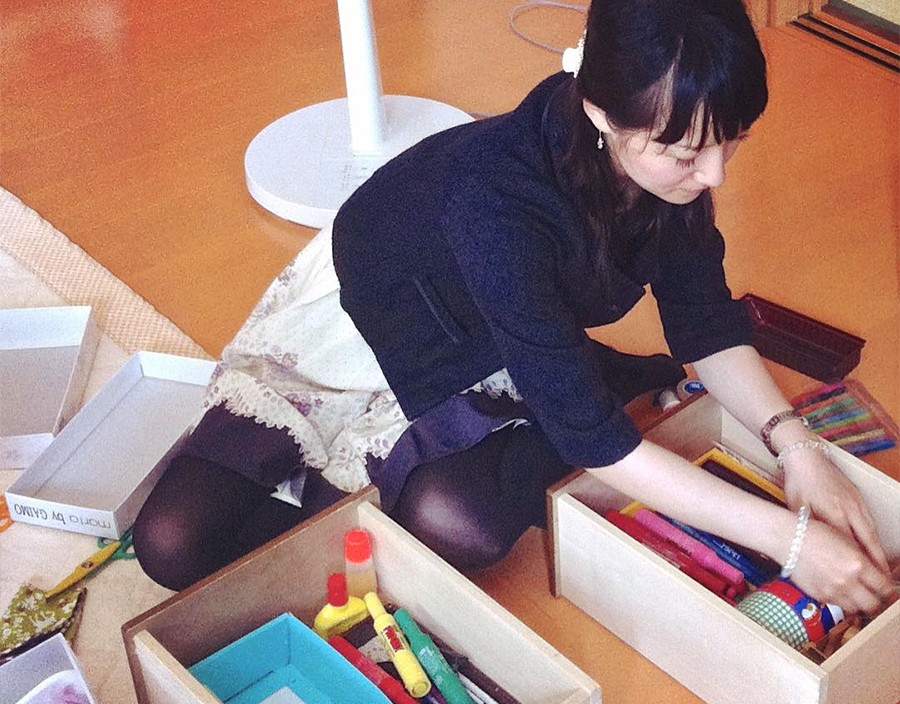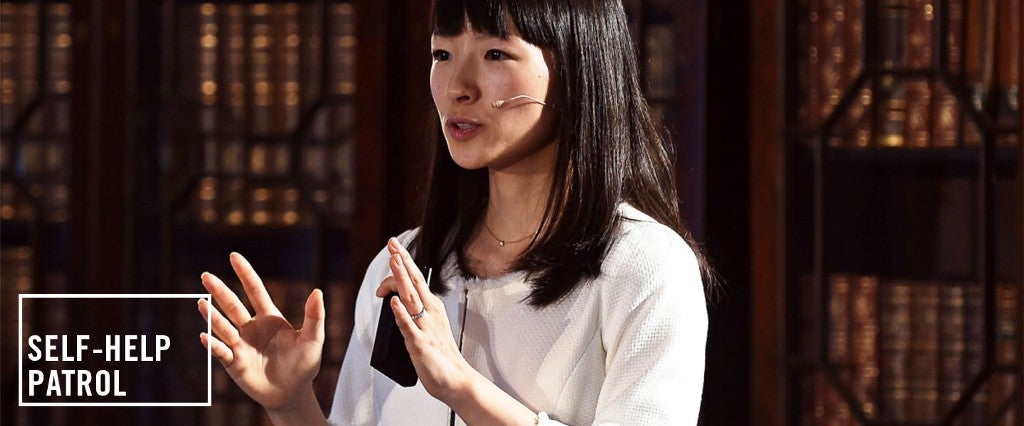Did my broken vape pen make me feel alive?
Not really.
Did a drawer full of thumbtacks and paper clips inspire happiness?
Absolutely not.
Did white sneakers — stained with mud since the first time I wore them — lift up my spirits?
Nope. In fact, they did the exact opposite.
Which meant, at least according to Japanese tidying guru Marie Kondo, her book The Life-Changing Magic of Tidying Up and its illustrated follow-up Spark Joy* (occupying the number one and two slots on the New York Times how-to bestseller list for 67 and 5 weeks, respectively) that I must throw them all away. In fact, by the time I had finished applying the KonMarie method to my apartment, I had parted ways with several suitcases and garbage bags worth of crap that didn’t meet Kondo’s criteria of “sparking joy” in my heart.
Declutter and reorganize like Kondo says, and you’ll never be a mess again.
This ruthlessness toward the ultimate goal of simpler living has turned Kondo into an international celebrity and has made tidying as trendy as a juice cleanse. “[W]hen we reduce what we own and essentially ‘detox’ our house, it has a detox effect on our bodies as well,” she writes. “We may get a bout of diarrhea or break out in pimples. There is nothing wrong with this.”
While I was spared the runs and acne, I still think Kondo is onto something transformative — in part, because she acknowledges that tidying is a folk science that most people never bother to learn, and in part, because most of what we think we know about tidying is utterly wrong.

Goal
Declutter and reorganize like Kondo says, and you’ll never be a mess again.
Strategy
Kondo urges readers to purge their whole place at once, starting with clothes, then books, papers, miscellany and mementos. There is one criterion and one criterion alone: Keep only the things that “spark joy” (unless, of course, you absolutely need them, like your social security card or bike rack, both of which I kept).
How exactly do you ‘spark joy’?
Here’s how she explains it as it pertains to your wardrobe: Once you’ve collected every item of clothing and piled it in one place, “you must take each outfit in your hand. When you touch a piece of clothing, your body reacts,” she writes. “Its response to each item is different,” she adds. If the reaction isn’t a joyful one, Kondo requires you to ditch it.
The book’s title refers to the “life-changing magic of tidying,” so there’s bound to be some questionable shit in here.
Do those squishy protocols work? Surprisingly, more often than not. It might make you feel ridiculous to ask yourself whether an inanimate object sparks joy (and what’s sillier is Kondo’s request that you thank each item before ditching it). But affection, it turns out, isn’t the main reason we keep things around. Most of the stuff I got rid of I didn’t care about and realized I could easily live without.
For the items that were a toss-up, Kondo provides decent supplementary advice. Feel guilty for not reading that classic piece of literature you feel stupid for never having read? Then it’s not sparking joy, so get rid of it. Feel bad about buying an expensive shirt and never wearing it? It sparked joy when you bought it, so it served its purpose in that moment. Get rid of it.
Who is Marie Kondo — and what makes her an expert?
There’s no MFA in Tidiness that Kondo can point to. Other than a brief stint as an attendant at Shinto temple, Kondo’s art is self-taught, starting at childhood. For whatever reason, the guru was preternaturally blessed with an obsession with order, which she began cultivating as an anti-social child who preferred spending time with things as opposed to people. She’s only released two books in English so far (there are more awaiting translation in Japanese) but as a consultant, she estimates that she’s helped clients get rid of more than 1 million items.
“I know it sounds like false advertising to claim that you can lose weight by tidying or that it will make your skin clearer, but it is not necessarily untrue.”
Also proof of her skill (albeit unverified): She claims she never has to tidy her Tokyo apartment. “Why? Because it is already tidy,” she writes. “I have time to experience bliss in my quiet space, where even the air feels fresh and clean; time to sit and sip herbal tea while I reflect on my day. As I look around, my glance falls on a painting that I particularly love, purchased overseas, and a vase of fresh flowers in one corner.”
It’s an image of minimalist joy: When you get rid of everything around your house you don’t care about, whatever’s left will inevitably make you happy.
Who’s the audience for this book?
Kondo makes clear that her most fervent fans and clients are women. In fact, I can’t remember a single reference to helping a male client. There are female-oriented tips (what to do with accessories, handbags, and stockings) without any male-specific ones. But her advice is so consistent that there’s no reason it should be gendered: Both men and women can be hoarders who also have to clean up after themselves.
What are the most questionable claims?
The book’s title refers to the “life-changing magic of tidying,” so there’s bound to be some questionable shit in here. Most suspicious are her claims that tidying will have a spiral effect on the rest of your life, making you happier, more successful, healthier and more attractive. “I know it sounds like false advertising to claim that you can lose weight by tidying or that it will make your skin clearer, but it is not necessarily untrue,” Kondo writes. “Unfortunately, I can’t show you before-and-after pictures of my clients, but I have witnessed with my own eyes how their appearance changes when their rooms are tidied. Their figures are more streamlined, their skin is more radiant and their eyes shine brighter.”
When you get rid of everything around your house you don’t care about, whatever’s left will inevitably make you happy.
Did it work?
Yes. My place never looked better, even a few months after my tidying marathon. My sock drawer remained a tourist attraction of perfect folded spirals for approximately three weeks. My closet is continuously refined in its organization. Gone are the dead plants, excess of magazines and mysterious chargers and cords — tokens of L.A. slob life that have hindered my best attempts at effecting a California minimalism. The space feels open and fluid. The cat seems happier.
Tidying is a skill that needs to be learned, and it seems like maybe Kondo taught me.
*This Kondo’ing session was administered pre-Spark Joy. The writer is not a visual thinker so it’s likely the presence of more detailed illustrations would not have significantly altered results.

